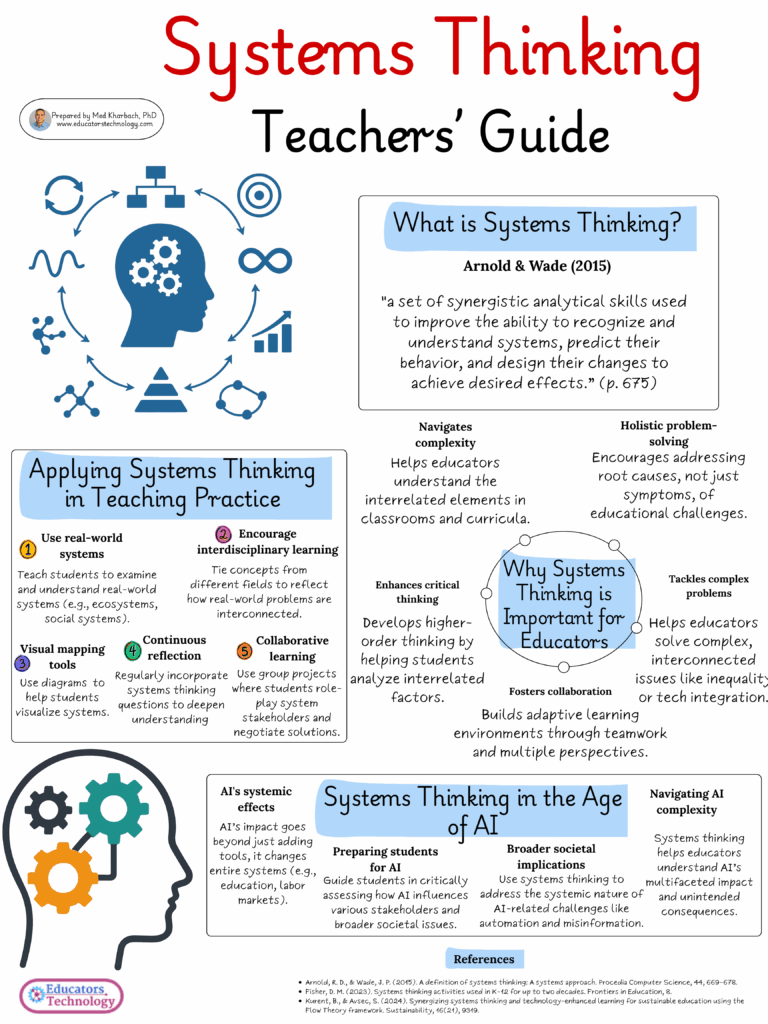If there’s one concept educators can no longer afford to ignore, it’s systems thinking. It’s not new. But it’s newly urgent. With the rapid rise of AI, the growing complexity of classrooms, and the layered nature of challenges like student engagement, curriculum design, and educational equity, the need for systems-level thinking is becoming more persistent.
Educators are working within increasingly interdependent structures (e.g., policies, technologies, social pressures, learning platforms) that interact in unpredictable ways. Systems thinking gives us a way to make sense of that.
This quick guide is designed as a starting point for those who are new to the concept or simply curious about what it offers in practice.
What Is Systems Thinking?
Let’s skip the jargon. In plain terms, systems thinking is a mindset and a set of skills for understanding how different elements within a system affect each other over time.
Arnold and Wade (2015) define it as:
“A set of synergistic analytical skills used to improve the ability to recognize and understand systems, predict their behavior, and design their changes to achieve desired effects.” (p. 675)
The key word here is synergistic. These skills don’t work in isolation. They build on one another. This isn’t checklist thinking. It’s relational thinking. It’s about grasping complexity without defaulting to oversimplification.
Why Systems Thinking Matters
We tend to treat educational problems as isolated events, low test scores, curriculum gaps, student disengagement. But these aren’t standalone issues. They’re symptoms of deeper structural patterns.
Systems thinking helps educators:
- Trace problems to their root causes
- See how short-term interventions produce long-term consequences
- Navigate change without getting trapped in tunnel vision
It’s a framework that aligns with complexity. And right now, education is nothing if not complex.
Applying Systems Thinking in Education
Understand Interconnections
No element of teaching exists in a vacuum. Curriculum design affects student motivation. Assessment pressures influence classroom culture. School policies ripple into teacher wellbeing. Systems thinking trains us to recognize these patterns and resist the urge to isolate cause and effect.
See the Whole Picture
This is about scale. What looks like a classroom issue might actually be a policy issue. What looks like a tech failure might really be a design flaw upstream. Systems thinking encourages us to zoom out before jumping in.
Focus on Patterns, Not Events
Events grab our attention. But it’s the recurring patterns underneath them that matter.
If your students are disengaged every Monday morning, that’s not a fluke, it’s a signal. Systems thinking helps us spot and respond to these deeper trends.
Use Feedback Loops
Education is full of feedback loops, both reinforcing and balancing. When students feel successful, they participate more. That increased engagement builds confidence, which leads to better performance, a positive feedback loop. The reverse is also true. Systems thinking helps us design for the loops we want, and interrupt the ones we don’t.
Think Long-Term
Quick fixes have long tails. When we adopt new tools or policies, we need to ask: What happens six months from now? A year from now? Systems thinking stretches our time horizon and forces us to consider downstream effects especially relevant in a world of rapidly evolving AI tools.
Manage Complexity
Classrooms are inherently complex systems. Diverse learners, intersecting needs, multiple stakeholders. Systems thinking doesn’t eliminate that complexity, but it gives us tools to work with it without falling back on one-size-fits-all approaches.
Systems Thinking and AI
AI is a systems disruptor. It touches assessment, writing, research, student support even identity formation. If we treat it as just a tool, we miss the point. Systems thinking helps educators evaluate AI in context: ethically, pedagogically, institutionally.
Final Thoughts
You don’t need to master systems theory to benefit from systems thinking. You just need to start using your critical thinking skills and ask better questions: What are the ripple effects? Where are the leverage points?
Who’s affected and how? This visual guide won’t answer those questions for you. But it will help you frame them. And that’s the work.


References
- Arnold, R. D., & Wade, J. P. (2015). A definition of systems thinking: A systems approach. Procedia Computer Science, 44, 669–678.
- Fisher, D. M. (2023). Systems thinking activities used in K–12 for up to two decades. Frontiers in Education, 8.
- Kurent, B., & Avsec, S. (2024). Synergizing systems thinking and technology-enhanced learning for sustainable education using the Flow Theory framework. Sustainability, 16(21), 9319. https://www.mdpi.com/2071-1050/16/21/9319#B34-sustainability-16-09319






